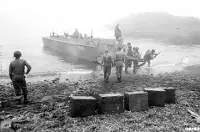The Making of the 50 States: Alaska
Having bought Alaska, the United States did relatively little to improve it for the next several years. More discoveries of gold followed, including a large one in 1888, 40 miles south of what is today Anchorage. Other locations of gold discoveries included Bonanza Creek, Mastadon Creek, and Windham Bay. 
The discovery of gold in the Yukon Territory of Canada resulted in an influx of thousands of treasure-seekers streaming through Alaska to get to the gold fields. Gold was soon found in Alaska, at Nome, along the Yukon River, and near what is now Fairbanks. Copper was discovered as well. The population soared, as did lawlessness. Congress created Civil Codes and laws to govern the area. Beginning in 1900, the territory had three judicial districts, with judges in Eagle, Sitka, and St. Michael. Juneau became the territorial capital, succeeding Sitka. Oil was discovered in 1902, near the settlement of Katalia, on the southern coast. Alaska soon had its first oil well. With the increase in population and settlement (or, in some cases, largely because of it) came the railroads: the White Pass in 1900, the Tanana in 1905, the Copper River and Northwestern in 1911, and the Alaska Railroad in the following decade. It wasn't until 1912 that Alaska became a territory. (It had changed from a Department to a District in 1884.) In 1913, the territorial legislature convened and passed a law giving women the right to vote. Workers built the Alaska Railroad, between Seward and Fairbanks, between 1914 and 1923. Alaska was the destination for many farmers whose livelihood had been destroyed by the Dust Bowl of the 1930s. The area was particularly hard hit by the Spanish Flu of 1918. 
The coming of World War II brought another influx of residents and industry to the state, which continued during the Cold War. The U.S. Military became Fort Richardson and Elmendorf Air Force Base in Anchorage in 1940. Japan invaded the Aleutian Islands in 1942, prompting not only a large concentration of American forces in the area for the remainder of the war (not to mention a series of conflicts) but also the construction of the 1,700-mile-long Alaska Highway, connecting the territory to the rest of the U.S., in less than nine months. 
As early as 1916, Alaska residents had petitioned Congress for statehood. They would have to wait. Residents of Alaska formed the Statehood Committee in 1949. In 1955, a Constitutional Convention resulted in a draft constitution, which was then approved by territorial voters the following year. The 1957 discovery of oil north of Sterling at the Swanson River (the first significant discovery of oil since 1902) accelerated the process. On Jan. 3, 1959, Alaska became the 49th state; the capital was Juneau. First page > In the Beginning > Page 1, 2 |
|
Social Studies for Kids
copyright 2002–2024
David White




